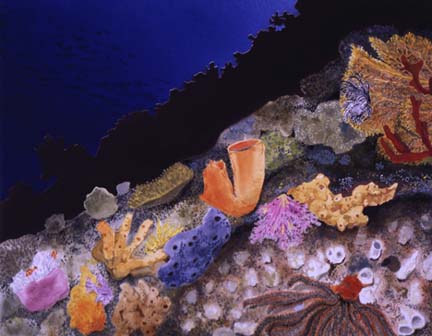

Story By TRACY WASHBURN
Illustrations by SOPHIE JAMES

Phil Crews has harvested thousands of sponges from the warm waters of Indonesia in the hope that one contains the cure to cancer. It's a numbers game, and one of these days he's going to hit the jackpot.
The rumble of the engine keeps UCSC research diver Beth Borgeson awake as the 75-foot converted fishing boat motors from the big island of Sulawesi in Indonesia to this remote speck of land in the waters of the Indo-Pacific. At sunrise she wriggles into a wetsuit and dons a tank and a mask. Although she's still slightly seasick from the night of rocking, Borgeson plunges in. Her dive buddy this trip is also her boss, Phillip Crews, a professor of chemistry at UCSC.
Submerged in the warm 75 degree (Fahrenheit) water, Borgeson and Crews swim down 70 feet, the deepest they'll search along the gradually sloping reef. They can see at least 80 feet through the clear blue water, enough to spot the kaleidoscopic orange, green and pink sponges along the reef. "Your mouth waters," Crews explains. "There are sponges everywhere." Like submarine honeybees, Crews and Borgeson alight on their first sponge, a two-foot wide arrangement of tan pipes. They photograph it and, wearing rubber dishwashing gloves, cut off a piece the size of half a loaf of bread and slip it into a Ziploc bag. After an hour, they've collected fragments from ten unique sponges, and they resurface, pulling a sponge-filled net sack behind them.

Crews has been studying the
chemistry of marine invertebrates
for more than two decades.Borgeson, Crews and ten other researchers will live on this boat nine days, and each day they'll repeat three times the cycle of harvesting sponge bits from the lush sprouting of life on the reef. Crews's group hunts sponges in the Indo-Pacific two or three times a year. Crews, himself, has been at it for more than two decades.
The researchers in Crews's team are playing a numbers game. They're searching for sponge defense chemicals, or toxins, to turn into useful anti-cancer drugs. Over the decades they've wrung the chemicals from more than a thousand different sponge species, so far finding just a few chemicals worth pursuing into preclinical cancer trials. And though many other research groups from around the world join Crews in pursuit of chemicals from the sea, no marine drug has yet hit the pharmaceutical market.
Finding anti-cancer drugs is particularly tricky. The chemical must be lethal to cancer cells while being much kinder to normal cells of the body. David Newman, head of the Marine Collection Program at the National Cancer Institute (NCI) in Bethesda, Maryland, expresses the subtlety. "If you want to look at it cold bloodedly," he says, "you're looking for a selective poison."
Yet if there's any place to find poisons to test, it's in the waters of the Indo-Pacific. The richest pot of marine chemicals lies in the triangle delimited by Singapore, the Philippines and New Guinea, Crews says.
Here lives the greatest number of sea species, and here the competition for survival is perhaps the stiffest anywhere, providing evolution ample opportunity to create potent chemical weapons. In particular, the soft and fleshy, brightly-colored, immobile creatures like sponges defend themselves with toxic chemicals.

Crews's team regularly returns to the Indo-Pacific
to dive for sponges.Sponges live especially densely on the Indo-Pacific underwater landscape. Borgeson estimates that at their densest, ten sponges live in a square area measuring five feet on a side. Other marine locales, such as the waters of Hawaii, sprout sponges only sparsely, thus earning the label "barren" from Borgeson.
Despite the daunting odds, however, plenty of reasons exist to spur on Crews's team to continue the hunt for new chemicals. Nature has already provided us most of our drugs. NCI's Newman, a self-described "totally biased zealot," emphasizes the importance of natural products to drug discovery: "Sixty percent of all drugs used to fight cancers or infections world-wide are natural products or have natural products in their ancestry," he says.
Although the pace of the search is slow, the researchers keep returning to these waters because they expect to find well-honed biologically active chemicals from nature's repository. Miranda Sanders, a member of Crews's team, describes her belief in their approach to finding potential medicines: "There are tons and tons of [chemical] structures, really interesting unique structures, in nature," she says. "It's kind of like looking for a needle in a haystack, but let's just go ahead and test all of them."




